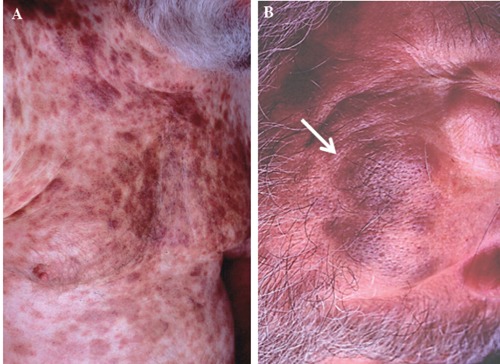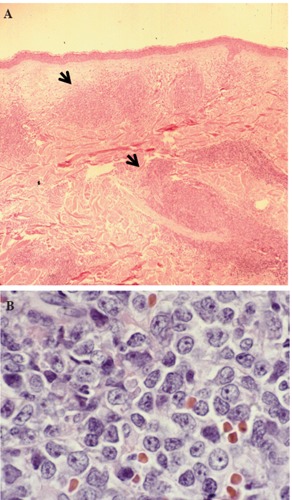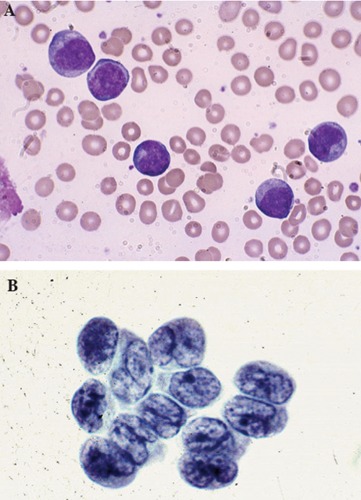Blastic NK cell lymphoma
Editor-In-Chief: C. Michael Gibson, M.S., M.D. [1]
Synonyms and keywords: Agranular CD4+CD56+ hematodermic neoplasm; CD4+CD56+ hematodermic neoplasm; HDT; Blastic plasmacytoid dendritic cell neoplasm; BPDCN;
Overview
Blastic NK cell lymphoma was first discovered by Adachi, an American hematologist, in 1994 following an unusual presentation of cutaneous lymphoma that express CD4 and CD56 antigens but no other T cell and B cell antigens. Blastic NK cell lymphoma is a type of lymphoma. It does not appear to be associated with Epstein Barr virus.[1]
Historical Perspective
- Blastic NK cell lymphoma was first discovered by Adachi, an American hematologist, in 1994 following an unusual presentation of cutaneous lymphoma that express CD4 and CD56 antigens but no other T cell and B cell antigens.[2]
Pathophysiology
- Blastic NK cell lymphoma is a type of lymphoma. It does not appear to be associated with Epstein Barr virus.[1]
- Blastic NK cell lymphoma is derived from plasmacytoid type 2 dendritic cell precursors. These dendritic cell precursors are possibly related to a common myeloid/NK-cell precursor cell.
- Blastic NK cell lymphoma is currently classified by World Health Organization Classification of Tumours of Haematopoietic and Lymphoid Tissues as an aggressive neoplasm derived from the precursors of plasmacytoid dendritic cells and categorically placed under the heading “Acute myeloid leukemia (AML) and related precursor neoplasms.”
- The pathogenesis of [disease name] is characterized by [feature1], [feature2], and [feature3].
- The deletion in 5q has been associated with the development of blastic NK cell lymphoma.
- On microscopic histopathological analysis, fine chromatin and scanty cytoplasm resembling lymphoblasts, or in some cases, myeloblasts, and may on occasion exhibit sub-membranous cytoplasmic vacuolations surrounding the nucleus are characteristic findings of blastic NK cell lymphoma.
- Tumor cells are invariably CD4+ and CD56+, and usually HLA-DR and CD45RA are positive as well. CD2 and CD34 are usually negative; and expression of TdT, CD7 and cytoplasmic CD3 is variable.
-
Hematoxylin & Eosin stain of skin lesion biopsy. Low power view of leukemic infiltrate corresponding to the raised plaque (A, black arrows) and high power view of the malignant cells in the skin infiltrate
-
Large malignant-appearing cells, with agranular cytoplasm, cleaved nuclei and prominent neocleoli on peripheral blood smear using Wright stain (A) and similar blast cells present in cerebrospinal fluid
Differentiating Blastic NK cell lymphoma from other Diseases
- Blastic NK cell lymphoma must be differentiated from hematological malignancies such as:
- Acute myeloid leukemia
- Human T-cell lymphotropic virus 1 associated adult T-cell leukemia/lymphoma
- Cutaneous NK/T-cell lymphoma
- Primary and secondary cutaneous pleomorphic T-cell lymphomas
Epidemiology and Demographics
- The prevalence of blastic NK cell lymphoma is unknown as it is an extremely rare disorder.[3]
Age
- Blastic NK cell lymphoma is more commonly observed amongmiddle-aged or elderly patients. The mean age at diagnosis is 66 years.[4]
Gender
- Males are more commonly affected with blastic NK cell lymphoma than female.
Natural History, Complications and Prognosis
- The majority of patients with Blastic NK cell lymphoma have an aggressive clinical course.
- Prognosis is generally poor, and the patient survives almost 1 year after the diagnosis.
Diagnosis
Cells are positive for CD4 and CD56.[5][6]
Symptoms
- Symptoms of blastic NK cell lymphoma may include the following:
- Nodules, plaques and patches of variable sizes on skin
Physical Examination
- Physical examination may be remarkable for:
- Nodules, plaques and patches of variable sizes on skin

Laboratory Findings
- There are no specific laboratory findings associated with blastic NK cell lymphoma.
Imaging Findings
- There are no imaging study findings associated with blastic NK cell lymphoma
Other Diagnostic Studies
- Blastic NK cell lymphoma may also be diagnosed using biopsy and immunochemistry.
Treatment
Medical Therapy
- The mainstay of therapy for blastic NK cell lymphoma is chemotherapy with CHOP or COP-like regimens.
Prevention
- There are no primary preventive measures available for blastic NK cell lymphoma.
References
- ↑ 1.0 1.1 Chan JK, Sin VC, Wong KF; et al. (1997). "Nonnasal lymphoma expressing the natural killer cell marker CD56: a clinicopathologic study of 49 cases of an uncommon aggressive neoplasm". Blood. 89 (12): 4501–13. PMID 9192774. Unknown parameter
|month=ignored (help) - ↑ Adachi M, Maeda K, Takekawa M, Hinoda Y, Imai K, Sugiyama S; et al. (1994). "High expression of CD56 (N-CAM) in a patient with cutaneous CD4-positive lymphoma". Am J Hematol. 47 (4): 278–82. PMID 7526680.
- ↑ 3.0 3.1 Saeed H, Awasthi M, Al-Qaisi A, Massarweh S (2014). "Blastic plasmacytoid dendritic cell neoplasm with extensive cutaneous and central nervous system involvement". Rare Tumors. 6 (4): 5474. doi:10.4081/rt.2014.5474. PMC 4274438. PMID 25568744.
- ↑ Hou, Steve; Jaworski, Joseph; Swami, Vanlila; Heintzelman, Rebecca; Cusack, Carrie; Chung, Christina; Peck, Jeremy; Fanelli, Matthew; Styler, Michael; Rizk, Sanaa (2015). "Blastic plasmacytoid dendritic cell neoplasm with absolute monocytosis at presentation". Pathology and Laboratory Medicine International: 7. doi:10.2147/PLMI.S71492. ISSN 1179-2698.
- ↑ Ng AP, Lade S, Rutherford T, McCormack C, Prince HM, Westerman DA (2006). "Primary cutaneous CD4+/CD56+ hematodermic neoplasm (blastic NK-cell lymphoma): a report of five cases". Haematologica. 91 (1): 143–4. PMID 16434387. Unknown parameter
|month=ignored (help) - ↑ Kim Y, Kang MS, Kim CW, Sung R, Ko YH (2005). "CD4+CD56+ lineage negative hematopoietic neoplasm: so called blastic NK cell lymphoma". J. Korean Med. Sci. 20 (2): 319–24. PMID 15832009. Unknown parameter
|month=ignored (help)

